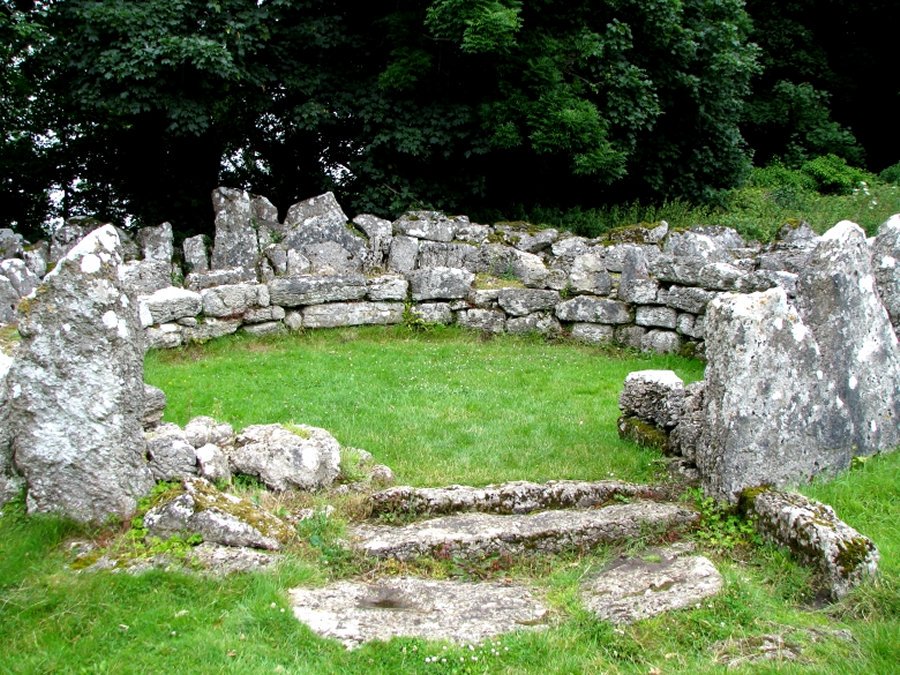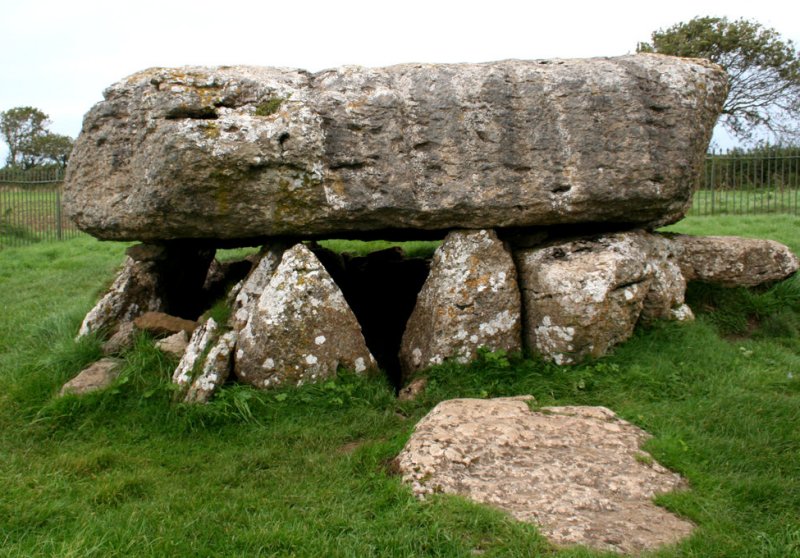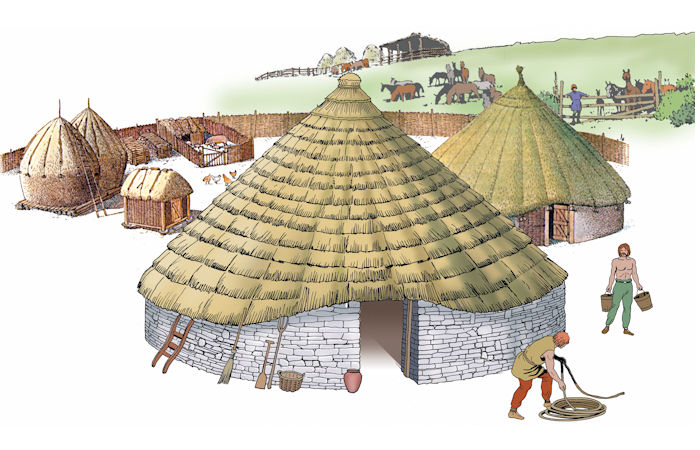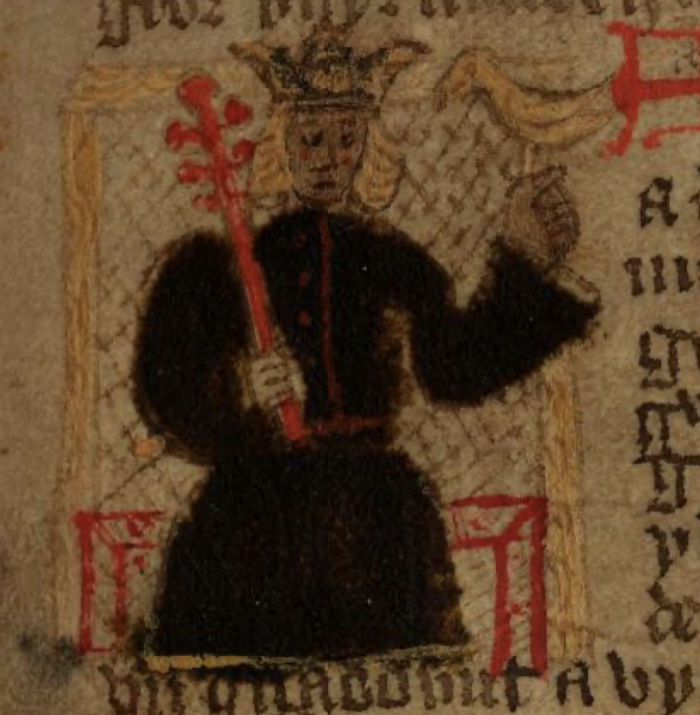A. Sutherland – AncientPages.com – The prehistoric ruins of the Din Lligwy settlement have a long history spanning three eras.
It is a fascinating place located on the eastern coast of Anglesey, Wales, United Kingdom, which has experienced continual, more than 5000 year-long human activity.

House foundations at Din Lligwy hut circle, Anglesey, August 2, 2004. Image credit: Velela – CC0 1.0 –Public Domain
The Din Lligwy Ancient Village (also known as the Din Lligwy Hut Group) represents a set of structures, including a Neolithic burial chamber, an Iron Age village, and an old, long-abandoned church. It was built by the native population of Anglesey during the latter part of the Roman occupation of Wales. But the origin of the settlement may well go back to the Iron Age.
Din Lligwy Burial Chamber consists of a circle of eight upright stones of differing shapes, all supporting a mᴀssive capstone, 5.9m by 5.2m and 1.1m thick. The mᴀssive capstone weighs approximately 25 tons, while the chamber has a height of about 2 meters. An earthen mound would have originally covered Lligwy. If such a cairn once covered this chambered tomb, no trace remains.
This ancient chamber, dated to c. 3000 BC, was excavated by archaeologists in 1908/9. They discovered the bones of men, women and children, along with animal bones, flint implements, shells, pottery and a bone pin.

Lligwy Burial Chamber. Image credit: Kate Heath – Flickr – CC BY 2.0
It is worth noting that even earlier (1905-07), excavations revealed hundreds of Roman potsherds dated back to the 3rd and 4th centuries AD, many repaired with iron clamps, pottery, and coins.
People focused on ironworking, smithing, and probably smelting, which is supported by smelting hearths and iron slag in some of the building remains. The settlement remains include a series of very well-preserved stone huts within a stone-walled enclosure.
Two rectangular huts contained six smelting hearths. One well-preserved Din Lligwy hut circle – probably dated from the 2nd to the 4th centuries AD – was occupied up to the Romano-British time.
Apparently, two different settlements once existed in the area. The grooved ware dates to the Neolithic period, and represented a pottery style of the British Neolithic.
Another one is beaker ware from the early Bronze Age. However, the presence of both grooved ware and beaker pottery would suggest that this tomb was in use during both the Neolithic and later, during the early Bronze Age.
At first, probably Iron Age Britons lived in the area. Excavations on the site revealed that the round structures were probably houses and the rectangular ones barns or workshops. Later, these people were influenced mainly by the lifestyle of the invading Romans. The settlement is one of several that existed in the Lligwy Valley

Credit: Adobe Stock – Mᴀssimo Todaro
It is believed that two rectangular huts contained six smelting hearths. At first, probably Iron Age Britons lived in roundhouses; later, these people were influenced mainly by the lifestyle of the invading Romans. The settlement is one of several in the Lligwy Valley.
Times when the Vikings invaded North Wales were troublesome.
Based on historical records, we know that a series of terrifying attacks by Viking invaders on the coasts of Britain, France and Ireland occurred in the last decade of the 8th century.
However, archaeological evidence shows that these invaders may not have been as devastating as records claim.
The first recorded raid on Wales occurred in 852, and later, further attacks by Vikings on Anglesey and Gwynedd from 854 onwards. Rhodri Mawr, the ruler of Gwynedd (844-78), led resistance to these early destructive attacks, killing the Danish leader Gorm in 855.

Rhodri Mawr, King of Wales/King of the Britons. Credit: Public Domain
In the meantime, Vikings – after being driven out of Dublin – came to Anglesey in 903. According to Irish and Welsh records, they failed to get established in Wales, so they decided to sail on to Chester. But again, in 918, Anglesey was ravaged by Vikings.
Frequent attacks occurred on the island during the second half of the 10th century on the island; Olaf of Dublin built a castle known as ‘Olaf’s Castle’ or ‘Castell Bon y Dom’ about the year 1000.
This one-sided historical record of Vikings terrorizing the land has now been transformed by archaeology. Viking contact was certainly hostile and brutal at times; however, in some areas, the Vikings rapidly settled as peaceful farmers. Archaeological excavations have provided evidence of these people as colonizers, skilled craftsmen, and merchants.
The nature of Viking settlement in Wales remains one of the mysteries of early medieval archaeology, none more so than on Anglesey. Vikings are strongly and undoubtedly historically ᴀssociated with the Isle of Man, Dublin, Chester, and the Wirral. Geographically, these places are also linked with the waters of Anglesey. Therefore, the activities in this area left their mark on Anglesey s history.
Written by – A. Sutherland AncientPages.com Senior Staff Writer
Copyright © AncientPages.com All rights reserved. This material may not be published, broadcast, rewritten or redistributed in whole or part without the express written permission of AncientPages.com
Expand for references
References:
Cadw
Anglesey Hidden Gem
The Journal of Antiquities
Wikipedia
Snowdonia Guide
Lligwy Burial Chamber





